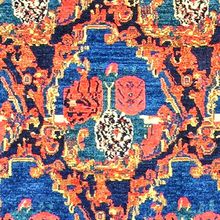Kurdi Rug
| Kurdi Rug | |
|---|---|
 Design of Kurdi Rug (Rugman) | |
| General information | |
| Name | Kurdi Rug |
| Original name | قالی کردی |
| Alternative name(s) | Kurdi Carpet |
| Origin | |
| Category | Tribal, Village, City |
| Technical information | |
| Common designs | Geometric, Buteh, Herati (Fish), Lacahk Toranj, Tribal |
| Common colors | Red, Blue, Navy Blue, Beige, Cream, Camel |
| Dyeing method | Natural, Synthetic |
| Pile material | Wool |
| Foundation material | Cotton, Wool, Silk |
| Knot type | Syemmetrical (Turkish), Asyemmetrical (Persian) |
History
Materials
Foundation and Pile
Kurdish seminomadic weavings are generally coarse in grade quality, with a wool foundation and a wool pile.[1]
Techniques and structures
Color and dyeing
Motifs and Designs
Weaving techniques
All solely employ the Turkish (symmetric) knot. Kurd seminomadic weavings are made for personal use and for sale in the markets. Flatwoven Kilim rugs, tribal items, small bags, and rugs in sizes up to approximately eight feet by five feet are made.[2]
See also
References
Bibliography
- Abraham Levi Moheban, (2015), The Encyclopedia of Antique Carpets: Twenty-Five Centuries of Weaving, NewYork: Princeton Architectural Press.